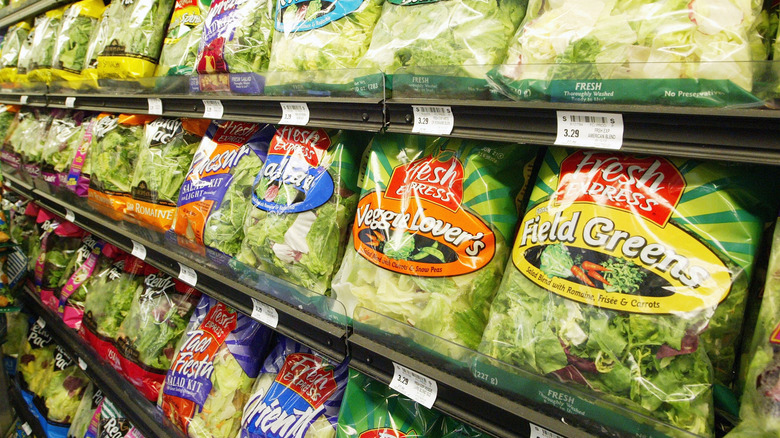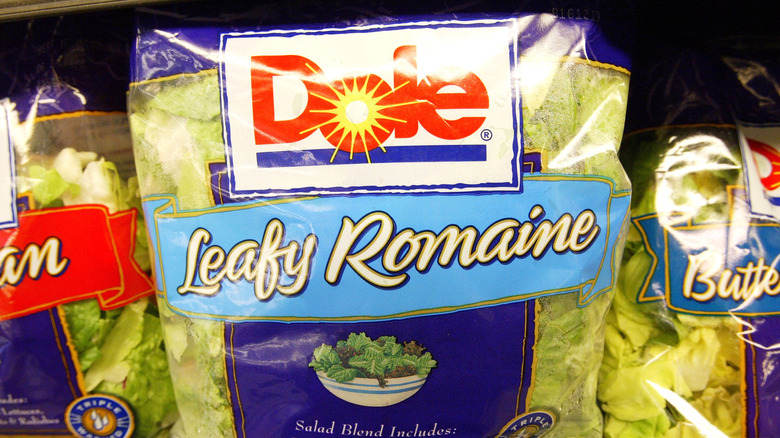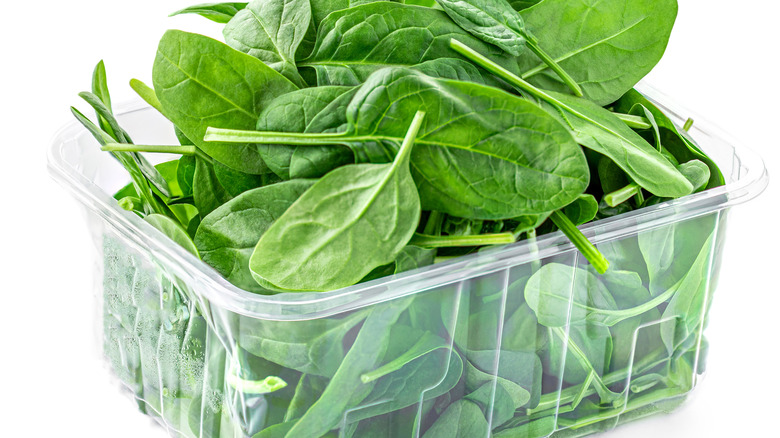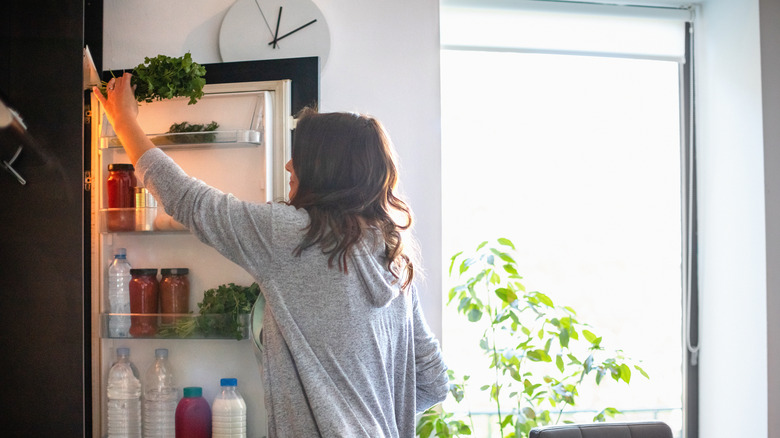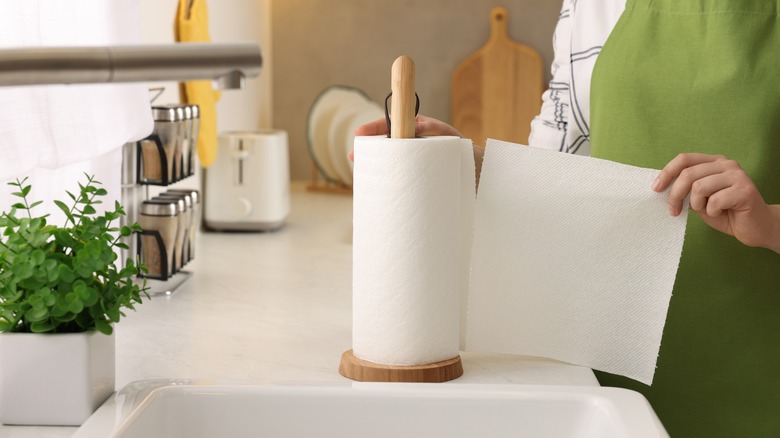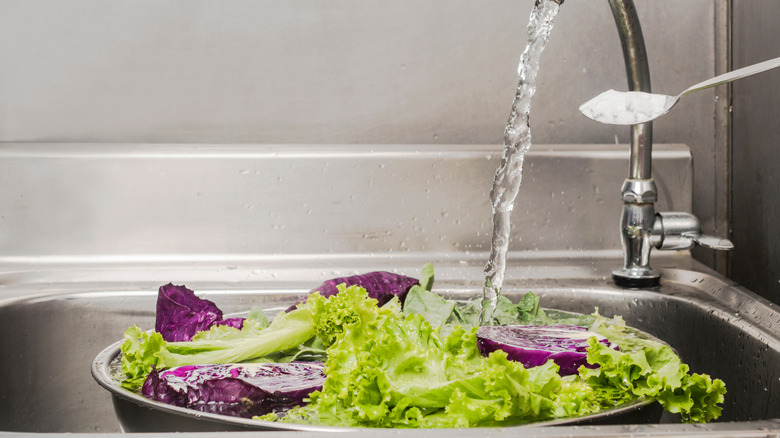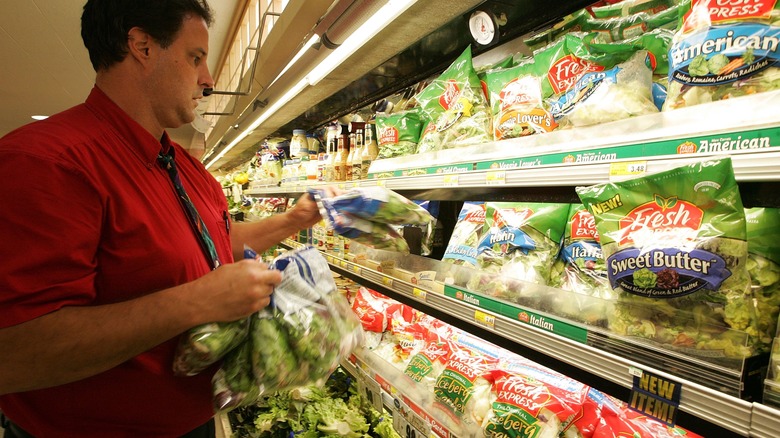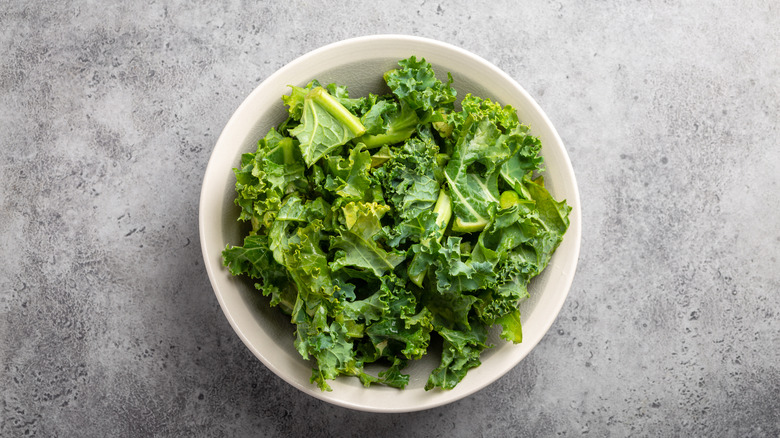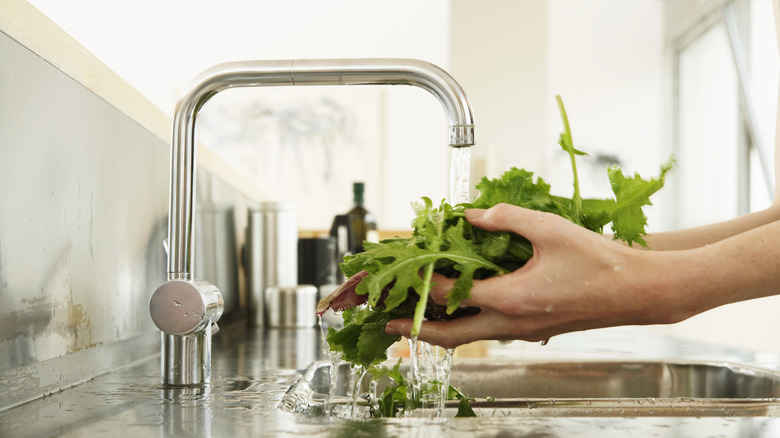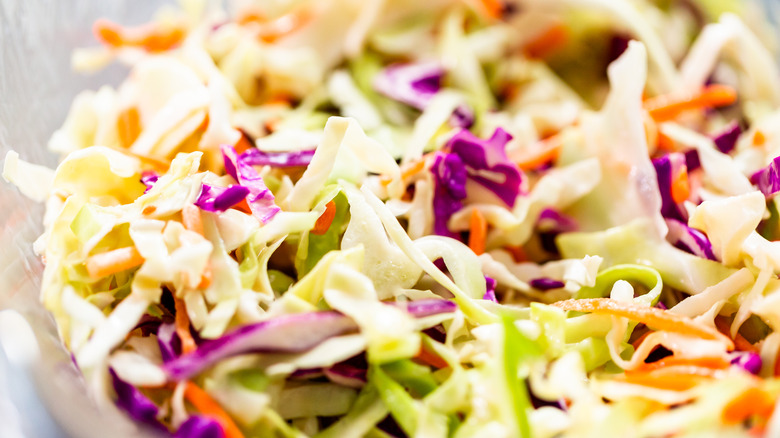Secrets About Bagged Salad You'll Wish You Knew Sooner
While many shoppers think of bagged salads as an everyday convenience food, they had their roots in the high-end farm-to-table restaurant movement of the 1980s. Farmers specialized in high-end salad ingredients such as edible flowers and dandelion greens, and they began delivering them to restaurants by wrapping them in towels and overnight shipping them in plastic bags.
The idea of prepackaged salad greens caught the attention of large food distributors and packagers — and just as they hoped, the bagged salads were a hit with busy home cooks, who loved that they were both healthful and convenient. However, they didn't come without challenges. We've all seen memes about that bag of mesclun that sits half-eaten in the fridge for five minutes before becoming so slimy it needs to be tossed, which makes some of us wonder if bagged salads are worth the trouble. And yes, bagged greens are fragile and need to be treated gently — but with a few simple techniques, you can ensure greens stay fresh and tasty down to the last bowlful.
Check expiration dates before buying
If you find your bagged salad greens going bad almost as soon as you get them home, it might not be because you're storing them wrong. A bag of greens from the store doesn't always mean fresh — the bag may have been lingering on the shelf for several days. To ensure you're bringing the freshest greens home, it's a good idea to check the expiration (or "best by") dates on bags before making your choice. This might mean rummaging a bit — the freshest and newest bags will often be in the back of the pile.
But while the dates on the bags are good indicators of relative freshness, they're not drop-dead dates for the safety of your greens. So if you store greens carefully and they still look good after the best-by date has passed, go ahead and eat them. They may not look as perky or firm as the day they were picked, but they will still be safe to eat.
Keep it cool on the drive home
Bagged greens are fragile, so to ensure they look and taste fresh when they reach your plate, it's important they be handled with care at every point, from the field to the first splash of salad dressing. We may joke about how quickly greens can go bad in those plastic bags, but in reality, manufacturers take great care in designing packaging for different greens, choosing packaging materials and methods specifically intended to foster the optimum temperature, humidity, and air exposure for each type.
While this is what makes it possible for bags of greens to be shipped across long distances, it doesn't make them bulletproof — you still have to do your part, starting as soon as you choose your bag of greens at the store. Ideally, you should keep them cool until you get home — so bring along an insulated bag on your next trip to the supermarket to store your greens and other perishables on your drive home.
If possible, choose clamshell containers rather than bags
While today's specially designed plastic bags for salad greens are a huge improvement over those first used for bagged salads in the 1980s, they can't protect the greens they hold from being shaken around or bruised in transit. And this can be problematic if you're shopping for more delicate greens, such as salad blends with soft lettuce leaves — bags containing these greens run a high risk of wilted or bruised leaves even when fresh.
So if you're shopping for more delicate greens and want to enjoy them over several days when you get them home, look for greens packed in plastic clamshell containers or domed containers rather than bags. (butter lettuce, an especially tender variety, is commonly sold in such containers.) These more rigid containers protect the greens from jostling and bruising, so you'll be far less likely to encounter bruised or wilted leaves once you get the package home.
Refrigerate your salad immediately once you get home
Cooler temperatures keep salad greens looking and tasting their best, so if you want your salads to be the freshest they can be, make a point of keeping your greens cold up until the time you're ready to serve them. This means not only keeping them cool on the way home from the store (you can do this by storing them in an insulated bag), but moving them straight from the bag to the refrigerator once you get home. This is critical for the longevity of your greens — if you take them out of their insulated bag and let them come up to room temperature before storing them, condensation may form inside the bag, which can facilitate wilting and rot.
It's also important to ensure your refrigerator is sufficiently cold (40 degrees or below) to keep greens and other perishables safe. Excess humidity is the enemy of your greens, so it's best to store them in the crisper drawer of your refrigerator, which is designed to circulate air and keep moisture from collecting — this will help prevent premature spoilage.
A paper towel inside an open bag of salad will help keep greens fresh
You may have noticed that an unopened bag of greens in your fridge can stay perfectly fresh for days, but once you open it, all bets are off — you may not be able to get more than a serving or two out of it before the leaves wilt into mush. You're not imagining things: Manufacturers often pump gases such as argon and nitrogen into the bags before sealing them to help slow the natural tendency of greens to deteriorate. But once the seal on the bag is broken, this protection is lost.
The biggest threat exposed salad greens face is moisture from your refrigerator, which can hasten spoilage. To keep moisture from collecting and condensing on your greens, insert a clean paper towel into your opened bag to wick any condensation away from the greens and clip the bag shut when storing it. If the paper towel starts to get damp (or soggy), replace it.
It's okay to eat bagged salad when you're pregnant – but wash it first
Among the many things expectant mothers have to worry about is whether the food they enjoy is safe for their baby in progress. Of course, it's critical to eat nutritious foods such as fresh greens during pregnancy, both for your own sake and that of the baby. But the occasional, high-profile reports about food poisoning cases traced to bagged salad mixes may give some folks pause — are these greens safe to eat during pregnancy?
For the most part, yes. Bagged salad greens are often labelled "triple washed," which means just that – they first go through an agitated water bath to rinse off any impurities, then a thorough antimicrobial wash, followed by a fresh water rinse before being dried and bagged. Thus, most cooks and eaters can safely rip open the bag, pour out some greens, and eat them as is. If you're pregnant, however, you might want to give these greens another rinse out of an abundance of caution. Also, you should be extra mindful to store your greens carefully — bacteria and other pathogens can proliferate on greens that are stored in warm areas or that have passed their expiration dates.
To revive wilted greens, try hot water
Something you've probably noticed about bagged salad greens is that they start to lose their perkiness after a few days in the fridge, especially if the bag has been opened. While this is normal and not dangerous, it's definitely a buzzkill: It's not fun serving (or eating) limp lettuce when you were looking forward to something fresh and crunchy.
The good news, however, is that this problem is totally fixable. While the more common (and perhaps more intuitive) method of crisping up old greens is to soak them in ice water, some experts suggest doing the exact opposite: soaking them in hot tap water (around 120 degrees F) instead. Don't worry, this isn't hot enough to cook (and further wilt) your greens. But it is warm enough to open up the cell walls of the greens quickly, allowing them to absorb water and firm up in a short amount of time. (If you think this sounds dubious, you'll be reassured to learn that florists have a longstanding practice of using warm water to perk up limp flowers — so heat does have a proven track record of reviving wilting vegetation.) After a short (10 to 30 minute) soak in hot water, your greens will be as good as new. Gently dry the revived greens in a towel, then shock them in ice water before serving.
Keep an eye on the bottom of the bag
Most of us have had the unpleasant experience of grabbing an opened bag of salad greens from the fridge, only to discover an ugly pool of green slime forming at the bottom of the bag. And even if these leaves on top look fine (and they probably are), it's enough to make you want to chuck the whole bag.
Bottom-of-the bag slime is, as you probably suspect, nothing more than decomposing vegetable matter. It's not only unappetizing and ugly, but unsafe to eat — disease-causing bacteria such as E. coli thrive in decaying material, so toss any greens that have started to become slimy or smell off. Greens at the bottom of the bag are more susceptible to turning slimy because they're more likely to get bruised or broken as the bag gets moved around. Breaks in their leaves release moisture, which can facilitate spoilage. So to keep vegetable rot at bay, check the bottom of the bag regularly and immediately remove and discard any wilted or damaged leaves.
Choose heartier greens, which will stay fresh longer
We get it, it's not always practical to handle all our groceries with kid gloves. For those of us with busy lives, it's sometimes a miracle that we manage to get to the market at all. And when we get home, where a million other things await on our to-do lists, our priority is getting everything put away as quickly as possible. And nope, that delicate bag of salad greens isn't going to get any special treatment; it'll get shoved into the crisper along with all the other produce, and if some of it gets smooshed and has to be tossed, so be it.
If this sounds familiar, know that you can keep bagged salad greens on hand without worrying about babying them all week — just choose heartier varieties that don't need to be handled with such care. Greens with more resilient leaves, such as kale and spinach, can survive a bit more rough treatment than softer and more delicate greens such as butter lettuce or mesclun. Even better, these hearty greens are a convenient add-in for cooked dishes as well as salads, so they offer even more bang for the buck.
Remove any wilted leaves immediately
You've heard the old saying, "One bad apple spoils the whole barrel" — this is based on the fact that a rotting apple can trigger the same chemical reactions in nearby fruit, causing them to go bad as well. The same holds for bagged salad greens – moisture and bacteria from just a few broken or bruised leaves can quickly spread to the rest of the bag. This means it's a good idea to get rid of any bruised or wilted leaves as soon as you see them if you want the rest of your greens to last.
One way to ensure no damaged greens even get into your refrigerator is to open your greens and inspect the leaves as soon as you get home. Lay out the leaves on dry paper towels and discard any that are wilted or have started to go slimy. Then, make sure the remaining leaves are completely dry before storing them in the refrigerator. Return them to the bag or transfer them to a sealed plastic container for storage.
Use your SodaStream to extend the life of your greens
You may have noticed that some bags of salad greens seem to be inflated with air. This isn't just for cushioning, and it's not just regular air. Rather, bags of salad greens are often infused with specialized mixtures of gases designed to slow the leaves' natural respiration and aging processes, helping them stay fresher longer.
Of course, once you open the bag, the gas dissipates, as does its protective effect. But if you have a SodaStream (or similar device) and a half-eaten bag of greens you'd like to keep in good shape for a few more days, you can use your SodaStream to re-create the packer's initial gassing process. Transfer your greens to a clean ziplock bag and seal the bag, leaving only a small opening for the SodaStream siphon. Press out as much air as you can, being careful not to bruise the greens. Insert the siphon into the opening and inflate the bag with CO2 before quickly removing the siphon and sealing the bag. This treatment allows your greens to last up to nine days (in contrast to the five days typical of untreated greens.)
Make bagged coleslaw mix your culinary secret weapon
Many home cooks complain about the potential waste of bagged salad greens — not only do they tend to go bad quickly, but eating them up before they go bad can become monotonous. Nothing wrong with a good salad, of course, but does anyone really want to eat salad with every meal until the bag is empty? Even serious salad fans, if they're being honest, might get bored. But the good news is bagged greens are a lot more versatile than many cooks think.
For instance, bagged coleslaw mix — not only is it a great timesaver when you're actually making coleslaw, it lends itself to any number of other preparations, both cooked and raw, that require large amounts of finely chopped vegetables. Sauté a handful or two to add crunch and color to homemade pad thai, simmer them in a hearty soup, or stir-fry with aromatics and meat to make a flavorful filling for egg rolls. It also makes a great topping for tacos and sandwiches. You can go through the whole bag without getting bored — and also spare yourself hours of chopping.

